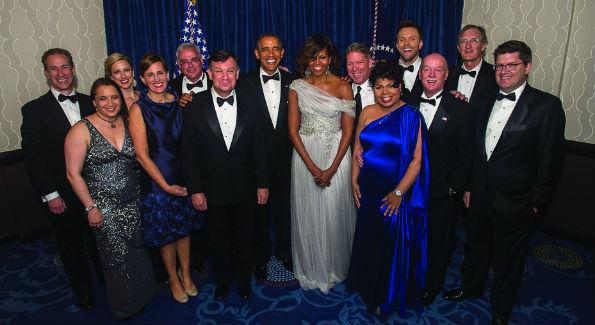Journalist April Ryan on “The Presidency in Black and White: My Up-Close View of Three Presidents and Race in America”
By Erica Moody
It takes courage to interview people in power, especially when you are asking tough questions. It’s something White House journalist April Ryan could write a book about. And that’s what she did, penning a concise and heartfelt insider’s account of more than 17 years covering the White House. “The Presidency in Black and White: My Up-Close View of Three Presidents and Race in America” (Rowman & Littlefield, $24.95) explores one reporter’s journey to ask about racial issues at White House press conferences while analyzing the efforts three presidents made to handle them during their terms in office.
Ryan drew from journals she kept as a longtime correspondent and bureau chief for American Urban Radio Networks. (She is also one of only three African Americans to serve on the White House Correspondent’s Association board.) The book is the result of many long nights of juggling a full-time job with a family, a two-hour commute (both ways) and the realization that writing it was much harder than she’d anticipated. After all, Ryan worked in radio, not print.
“It was challenging in the fact that I’m a radio person who believes in sound bites,” Ryan told us. But you can’t get a book from thirty-second sound bites.
She enrolled in a Johns Hopkins University writing course and began to look at writing from a craft perspective. She wrote articles for Baltimore Magazine and the Huffington Post, and then for her own blog. “Writing was an evolution for me,” she says, reflecting on the process that began over a decade ago.
“I would steal away in my brother’s office to write the book,” she says. “I could go there on a Friday night at nine and leave when the sun came up. I would wake up early, when the kids were still sleeping, or in the middle of the night and write.”
Getting the content right required much reflection, looking back on her history of following Bill Clinton, George W. Bush and Barack Obama. She even went back to the presidents for updated interviews. “Time was on my side because we had these great stories,” Ryan says. “I wanted the people to have something that was a good, factual read.”
She gets personal as well, taking her readers to the beginning of her career as a reporter, delving into the challenges she faced in covering the news for a “specialty” media outlet.
“The reward of being in specialty media is that you’re not part of the group that asks the same questions,” she says. “The front two rows harp on the same questions but when you go back in that room, there are other issues that people have questions about from other parts of America. I ask all of the questions, but I focus on urban minority America. The downside is that many of my colleagues think I cause the room to lose momentum. There are so many issues out there beyond the Hillary Clinton emails and the Iran investigations.”
We asked her what she thinks the most pressing issue is to her audience right now.
“In broad brushstrokes: economics,” she replies. “That translates into jobs, education, housing. And then you have the issue of racism. Race plays into economics, housing, so many areas. We still have issues of racism around this country and it’s a problem. Racism is the umbrella and the other issues fall underneath,” she says. “We created the blueprint for the civil rights movement of the ’50s and ’60s. Unfortunately we have walked away from it. We have not galvanized to use that blueprint.”
Racism, she believes, is something that should be addressed, or at least acknowledged, by the president. She explains in her book:
“I was sure that once I walked through those [White House] doors, I’d see things that were changing and that there was hope for a government that wanted to represent all people. However, as I watched each president get sworn in and take office, it only took a few months before the good intentions gave way to political favors and party tradeoffs.”
Ryan’s insights into the presidents are often eye-opening and observed with both empathy and humor. She takes a surprisingly sympathetic view of Bush, whom she got to know personally over the years of his administration. “What I saw in George W. Bush’s policies and politics,” she says, “did not match who he was as a person to me.”
The book concludes with each president being graded with a “Race Report Card” in five categories: administration diversity, apology/reparations, domestic outreach, international outreach and jobs/unemployment. Overall, Clinton and Obama received B-pluses and Bush a C-minus. Ryan believes that no president in recent history has tackled race to A-plus standards, but has hopes for the future.
“I’d love to see a president who is more inclusive of all people, and who would stand up in the first term rather than the second. It’s unfortunate we’re targeting groups now instead of being a president for everyone. I’d love to see a president focus on bringing everyone to the table.”
This article appeared in the April 2015 issue of Washington Life.

